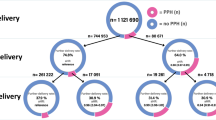Abstract
Objective
The aim of this study was to identify the factors associated with the increased risk of postpartum hemorrhage requiring transfusion in Japanese twin pregnancies in comparison with those in Japanese singleton pregnancies.
Methods
We reviewed the obstetric records of all singleton and twin deliveries after 22 weeks’ gestation at the Japanese Red Cross Katsushika Maternity Hospital from 2003 through 2011. Potential risk factors for transfusion due to hemorrhage after cesarean delivery were selected according to previous studies of postpartum hemorrhage or transfusion or both after delivery: maternal age, parity, previous cesarean deliveries, history of infertility therapies such as in vitro fertilization, gestational age at delivery, neonatal birth weight, placenta previa, uterine myoma ≥6 cm, hypertensive disorders, placental abruption, emergency cesarean deliveries and general anesthesia.
Results
Using multiple logistic regression, the independent risk factors for postpartum hemorrhage requiring transfusion in singleton pregnancies were preterm delivery [odds ratio (OR) 2.40, 95 % confidence interval (CI) 1.2–4.6, p < 0.01], placenta previa (OR 8.08, 95 % CI 3.9–16, p < 0.01) and placental abruption (OR 12.8, 95 % CI 2.3–76, p < 0.01). In twin pregnancies, however, the independent risk factors for postpartum hemorrhage requiring transfusion were gestational age at ≥41 weeks (OR 8.20, 95 % CI 1.3–40, p < 0.01) and hypertensive disorders (OR 5.45, 95 % CI 2.2–14, p < 0.01).
Conclusions
The factors associated with postpartum hemorrhage requiring transfusion in cesarean deliveries of twins seemed to be different from those in singleton cesarean deliveries.
Similar content being viewed by others
References
Ananth CV, Demissie K, Smulian JC, Vintzileous AM (2003) Placenta previa in singleton and twin births in the United States, 1989 through 1998: a comparison of risk factor profiles and associated conditions. Am J Obstet Gynecol 188:275–281
Bonnar J (2000) Massive obstetric haemorrhage. Baillieres Best Pract Res Clin Obstet Gynaecol 14:1–18
Borgida AF, Grabo H, Bobrowski RA, Ingardia CJ (2006) Trends in mode of delivery of twins from 1999 to 2004. Obstet Gynecol 107:66S–67S
Chang CC, Wang IT, Chen YH, Lin HC (2011) Anesthetic management as a risk factor for postpartum hemorrhage after cesarean deliveries. Am J Obstet Gynecol 205:462.e1–462.e17
Chen CL, Cheng Y, Wang PH, Juang CM, Chiu LM, Yang MJ, Hung CS, Yang ML (2000) Review of pre-eclampsia in Taiwan: a multi-institutional study. Zhonghua Yi Xue Za Zhi (Taipei) 63:869–875
Combs CA, Murphy EL, Laros RK Jr (1991) Factors associated with hemorrhage in cesarean deliveries. Obstet Gynecol 77:77–82
Cunningham FG, Leveno KJ, Bloom SL, Hauth JC, Gilstrap L, Wenstrom KD (2005) Multifetal gestation. In: Cunningham FG, Leveno KJ, Bloom SL, Hauth JC, Gilstrap L, Wenstrom KD (eds) Williams obstetrics, 22nd edn. McGraw Hill, New York, pp 911–943
Druelinger L (1994) Postpartum emergencies. Emerg Med Clin North Am 12:219–237
Gilbert L, Porter W, Brown VA (1987) Postpartum hemorrhage. Br J Obstet Gynaecol 94:67–71
Kamani AA, McMorland GH, Wadsworth LD (1988) Utilization of red blood cell transfusion in an obstetric setting. Am J Obstet Gynecol 159:1177–1181
Magann EF, Evans S, Hutchinson M, Collins R, Lanneau G, Morrison JC (2005) Postpartum hemorrhage after cesarean delivery: an analysis of risk factors. South Med J 98:681–685
Mendelson CL (1965) Multiple pregnancy. In: Greenhill JP (ed) Obstetrics, Asian ed, 13th end. Igaku Shoin, Tokyo & Osaka, pp 617–630
Minakami H, Watanabe T, Izumi A, Matsubara S, Koike T, Sayama M, Moriyama I, Sato I (1999) Association of a decrease in antithrombin III activity with a peripheral elevation in asparatate aminotransferase in women with twin pregnancies: relevance to the HELLP syndrome. J Hepatol 30:603–611
Norris CT (1997) Management of postpartum hemorrhage. Am Farm Physician 55:635–640
Redman CWG, Bonnar J, Beillin L (1978) Early platelet consumption in pre-eclampsia. BMJ i:467–469
Shaheen B, Hassan L (2007) Postpartum haemorrhage: a preventable cause of maternal mortality. J Coll Physicians Surg Park 17:607–610
Sheiner E, Sarid L, Levy A, Seidman DS, Hallak M (2005) Obstetric risk factors and outcome of pregnancies complicated with early postpartum hemorrhage: a population-based study. J Matern Fetal Neonatal Med 18:149–154
Shevell T, Malone FD (2003) Management of obstetric hemorrhage. Semin Perinatol 27:86–104
Suzuki S (2009) Risk factors for emergency cesarean delivery for the second twin after vaginal delivery of the first twin. J Obstet Gynaecol Res 35:467–471
Suzuki S, Inde Y, Igarashi M, Miyake H (2008) Elective cesarean as a risk factor for transfusion after delivery of twins. J Nippon Med Sch 75:247–249
SuzukiS YamashitaE, Inde Y, Hiraizumi Y, Satomi M (2010) Increased rate of elective cesarean delivery and neonatal respiratory disorders in twin pregnancies. J Nippon Med Sch 77:93–96
Suzuki S, Yoneyama Y, Sawa R, Araki T (1999) Maternal plasma adenosine levels in pregnancies complicated by toxemia. Trophoblast Res 13:407–414
Weiner CP, Kwaan HC, Xu C, Paul M, Burmeister L, Hauck W (1985) Antithrombin III activity in women with hypertension during pregnancy. Obstet Gynecol 65:501–509
Wen SW, Fung KFK, Oppenheimer L, Demissie K, Yang Q, Walker M (2004) Neonatal mortality in second twin according to cause of death, gestational age, and mode of delivery. Am J Obstet Gynecol 191:778–783
Conflict of interest
We declare that we have no conflict of interest.
Author information
Authors and Affiliations
Corresponding author
Rights and permissions
About this article
Cite this article
Suzuki, S., Hiraizumi, Y. & Miyake, H. Risk factors for postpartum hemorrhage requiring transfusion in cesarean deliveries for Japanese twins: comparison with those for singletons. Arch Gynecol Obstet 286, 1363–1367 (2012). https://doi.org/10.1007/s00404-012-2461-9
Received:
Accepted:
Published:
Issue Date:
DOI: https://doi.org/10.1007/s00404-012-2461-9




